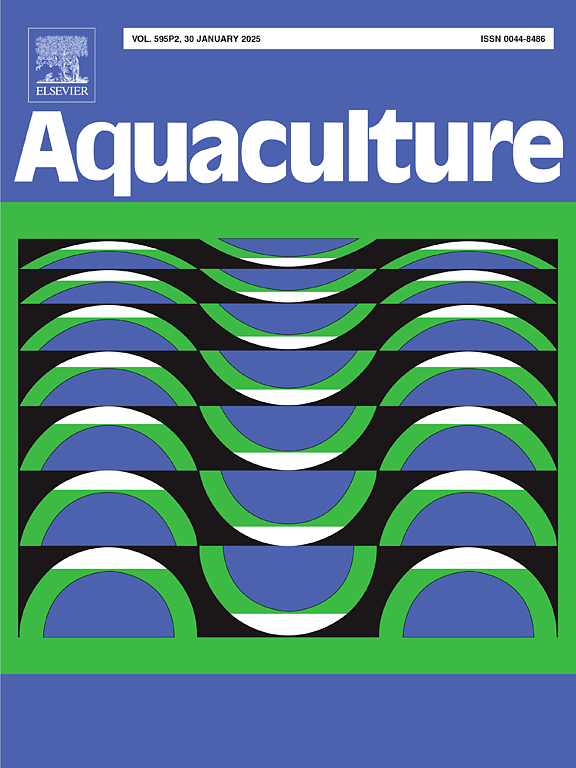Seasonal dynamics of gut microbiota in Chinese soft-shelled turtles (Pelodiscus sinensis): Implications for sustainable aquaculture practices
IF 3.9
1区 农林科学
Q1 FISHERIES
引用次数: 0
Abstract
The gut microbiota significantly influences host health, yet its seasonal dynamics in reptiles—especially in farmed species like Chinese soft-shelled turtle (Pelodiscus sinensis)—remain largely unexplored. Considering the unique physiology of reptiles and their distinct seasonal behaviors, understanding these dynamics is crucial for optimizing management strategies. This study investigated seasonal changes in the gut microbiota of Chinese soft-shelled turtles and the underlying community assembly mechanisms. Large intestine samples were collected and analyzed using 16S rRNA gene sequencing, with seven samples obtained each season. Results indicated that summer exhibited significantly higher richness than autumn and winter, as confirmed by the Shannon and Simpson indices, while evenness was significantly greater in summer compared to autumn with a near-significant trend versus winter (P = 0.053). Beta diversity analysis showed significant seasonal clustering, indicating seasonality's impact on the gut microbiota structure. Dominant phyla included Firmicutes, Bacteroidota, Proteobacteria, and Actinobacteriota. The relative abundance of Bacteroidota increased during autumn and winter, while Firmicutes decreased, suggesting an energy source shifts during hibernation. Functional predictions indicated seasonal differences in glycan biosynthesis and metabolism pathways. Community assembly analysis indicated increased stochastic processes in autumn and winter, while deterministic processes dominated in summer. This shift towards stochastic processes during colder seasons likely results from greater environmental variability, such as temperature fluctuations and reduced food availability. Fourteen operational taxonomic units were shared across all seasons, displaying cooperative interactions. The presence of potentially pathogenic genera like Edwardsiella and Aeromonas in winter suggested a possible link to post-hibernation mortality. These findings provide valuable insights into how Chinese soft-shelled turtles adapt to seasonal changes through gut microbiota shifts, offering improved knowledge for aquaculture management.
肠道微生物群对宿主的健康有重大影响,但爬行动物(尤其是中华鳖等养殖物种)肠道微生物群的季节性动态在很大程度上仍未得到研究。考虑到爬行动物独特的生理机能及其独特的季节性行为,了解这些动态变化对于优化管理策略至关重要。本研究调查了中华鳖肠道微生物群的季节性变化及其潜在的群落组装机制。研究人员采集了大肠样本,并使用 16S rRNA 基因测序法对其进行分析,每个季节采集 7 个样本。结果表明,夏季的丰富度明显高于秋季和冬季,香农指数和辛普森指数也证实了这一点;夏季的均匀度明显高于秋季,与冬季相比有接近显著的趋势(P = 0.053)。贝塔多样性分析显示出明显的季节性聚类,表明季节性对肠道微生物群结构的影响。占优势的菌门包括固相菌门、类杆菌门、变形菌门和放线菌门。类杆菌在秋冬季节的相对丰度增加,而真菌则减少,这表明冬眠期间能量来源发生了变化。功能预测表明,糖类生物合成和代谢途径存在季节性差异。群落组装分析表明,秋冬季节随机过程增多,而夏季则以确定过程为主。这种在寒冷季节向随机过程的转变可能是由于环境变异性更大,如温度波动和食物供应减少。所有季节共有 14 个可操作的分类单元,显示出合作性的相互作用。冬季出现的潜在致病菌属(如爱德华氏菌和气单胞菌)可能与冬眠后死亡有关。这些发现为了解中华鳖如何通过肠道微生物群变化来适应季节变化提供了宝贵的见解,为水产养殖管理提供了更多的知识。
本文章由计算机程序翻译,如有差异,请以英文原文为准。
求助全文
约1分钟内获得全文
求助全文
来源期刊

Aquaculture
农林科学-海洋与淡水生物学
CiteScore
8.60
自引率
17.80%
发文量
1246
审稿时长
56 days
期刊介绍:
Aquaculture is an international journal for the exploration, improvement and management of all freshwater and marine food resources. It publishes novel and innovative research of world-wide interest on farming of aquatic organisms, which includes finfish, mollusks, crustaceans and aquatic plants for human consumption. Research on ornamentals is not a focus of the Journal. Aquaculture only publishes papers with a clear relevance to improving aquaculture practices or a potential application.
 求助内容:
求助内容: 应助结果提醒方式:
应助结果提醒方式:


